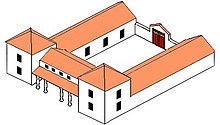Villa rustica (Oberhaunstadt)
The villa rustica at Oberhaunstadt , a district of the independent city Ingolstadt in Bavaria , is a very small, only by air image reporting and field inspection known Roman estate dating from the 3rd century AD. It exemplarily shows one of the lowest levels of agricultural production facilities in the former Roman province of Raetia .
Research history
The farm became known through aerial photo archaeologist Otto Braasch , who discovered it between 1977 and 1981. Field inspections were then carried out. Excavations have not yet taken place at this ancient site, the remains of which are massively endangered by agriculture.
Finding
The rectangular villa rustica from the 3rd century , measuring approximately 22 × 26 meters, has on its front side the corner projections typical of Roman estates , which can impressively emphasize the facade, especially in larger and larger courtyards. In Oberhaunstadt, too, it is to be expected that the almost square, tower-like projections were two-story and in any case towered over the roof landscape of the house. Since only the surrounding walls of the main building are visible in the aerial photo, the entire interior construction will have been carried out in half-timbered construction. Think of a square-shaped system grouped around an inner courtyard or just running along the flanks. In the latter case, the rear wall could only have been designed as a wall, in which there was a large barn-like gate. The villa may have had a wooden portico set in front of the facade , otherwise no development is to be expected here. As the field inspection showed, the plow in one of the risalits constantly breaks screed and stone debris from the ground, which could indicate that the house could at least have had the modest luxury of a heated room.
No further traces of stone or wooden farm buildings are known from the aerial photo. There also does not seem to have been a stone surrounding wall.
Monument protection
The Villa rustica discussed here and other facilities mentioned are ground monuments according to the Bavarian Monument Protection Act (BayDSchG). Investigations and targeted collection of finds are subject to approval, and accidental finds are reported to the monument authorities.
literature
- Rainer Christlein , Otto Braasch: The underground Bavaria . 3. Edition. Konrad Theiss Verlag, Stuttgart 1998, ISBN 3-8062-0855-7 , p. 196, ill. P. 197.
Coordinates: 48 ° 47 ′ 30.8 " N , 11 ° 26 ′ 32.8" E

